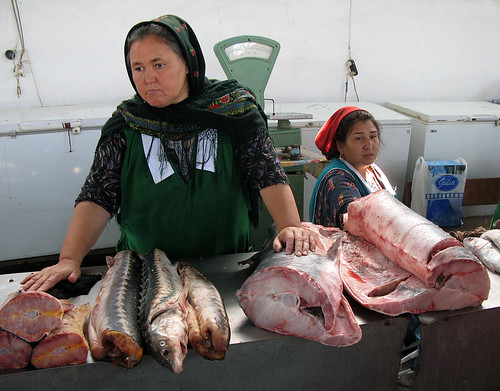The Last Days Of The Fulton Fish Market

Image by drp
It's 4:30 AM in the morning. Freezing, cold wind blasts off Manhattan's East River. The last of New York City's drunken revelers are sauntering home, but Mike Cioffi, braving the chill in a bomber jacket, fingerless gloves, and carrying a one-foot steel fishhook, has work to do. He is a fishmonger at the Fulton Fish Market in downtown Manhattan. Like many of the men at this market, Cioffi has worked in the same spot where he now stands for 35 years. "It was like I was born here," he says.
At 184 years, the Fulton Fish Market is America's oldest. Every morning from 2 AM until a little after 9 AM its cobblestone streets are bustling with speeding forklifts, white delivery vans, crates of fish stacked five high, and fishmongers like Cioffi. Ships once docked directly at this port, but today fish is delivered almost exclusively by truck.
Soon the stalls, the men, and of course the fish will be moved into a sprawling, new location at Hunts Point in the Bronx. What won't be moved are the market's rough charm and the deep-rooted sense of history that this place engenders. "I hate to see the market move because of the history. It's progress I guess," says Ronni Di Gregario, who has worked at the market for 32 years.
The city is quick to advertise the new 400,000-square-foot facility's modern refrigeration, increased loading space, and executive offices. They have been less clear on development plan s for the evacuated market on Fulton Street, but judging by its proximity to the tourist-heavy South Street Sea Port and the sky rocketing value of Manhattan real estate, an expansion of the Sea Port's shopping malls, restaurants, and residential complexes seems likely.
Some at the Fulton Fish Market are excited about the new location, anticipating increased business from being next to Hunt's Point's meat and vegetables markets. "I am looking forward to the move," says Michael Driansky, who put two kids through college on his 28 years of service at the market. "It's going to be one-stop shopping."
"It's going to be a better environment," agrees Patrick Grosso. "After 28 years outside, I feel like a weathered fence, even though I look good for my age."
St ill most of the men - there are no women on the market floor and few in the upstairs offices - seem morose over the move. "This is part of us," says Mike Rizzoto, spreading his arms out to the frenetic bustle of forklifts, steel hook-carrying men, and deep, blue, morning sky.
It's now 6 AM and dawn is breaking across the water, spreading warm tendrils of orange light through the spires of the Brooklyn Bridge and lighting up the top half of the market's two-story buildings. A few yards away, a group of men gathers around a metal trashcan. Spent fish crates and driftwood are burning inside of it, sending huge flames and smoke into the air. Pat O'Conner, who has lived on the streets around the market for 16 years, is among them.
Thumbing an open can of Mustang malt liquor only half hidden in his winter coat, O-Conner details the names of the loading bays by the water: Coal Chute, Pier 20, and Stephanie. A red brick building behind him, now prime real estate, was once a brothel, he explains. He puts his hands forward and warms them over the small inferno inside the trashcan. Three Korean men huddle near, keeping themselves warm and adding driftwood to the burning pile.
Despite not actually having an official job at the market - sometimes he helps move crates for a few dollars - O'Conner plans on leaving with it to Hunt's Point. "Down here it's more like a family," he says of the deep camaraderie at the market. "I think the people here, they are going to miss us."
- Work Magazine
__________________________________________________
If you can, please make a contribution towards the disaster relief efforts
in India and Pakistan (as well as continuing efforts in New Orleans and
Texas) by donating to the Red Cross/Red Crescent.
__________________________________________________
[ ]
As a way of returning the extraordinary generosity and support you
have all shown me in this great community, whenever I upload a new
pic or series of shots this year, I'll provide a link to another flickr
photog whose work, personality, or spirit I feel you should discover.
Visit and introduce yourself. Make a friend. Share the love.
Open your eyes to GeGu today.
«Let's eat the fish before others take it!»

Image by Tambako the Jaguar
A cute Indian otter eating a fish with a great enthusiasm. On the right you can see other otters.
Picture taken in the zoo of Zürich, Switze rland.
Fish Market / Turkmenistan, Krasnovodsk

Image by flydime
Sturgeon is the common name used for some 26 species of fish in the family Acipenseridae, including the genera Acipenser, Huso, Scaphirhynchus and Pseudoscaphirhynchus. The term includes over 20 species commonly referred to as sturgeon and several closely related species that have distinct common names, notably sterlet, kaluga and beluga. Collectively, the family is also known as the True Sturgeons. Sturgeon is sometimes used more exclusively to refer to the species in the two best-known genera; Acipenser and Huso (http://en.wikipedia.org/wiki/Sturgeon).
Canon G7
No comments:
Post a Comment